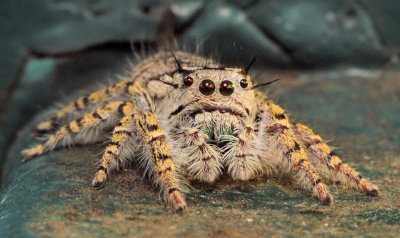Jumping Spider
Category: Arachnida Spider

Facts about Jumping Spider, "scientific name for Jumping Spider is Phidippus mystaceus". Do you have any idea about jumping spiders? Well if not, here are some facts that you should know about them, they are called jumping spiders simply because they can jump 10 to 40 times their body length, they consist of 4000 described species and this makes them the largest family of spiders, they have a sharper vision than any other animal of its size since it has large principal eyes, the jumping spider has four pairs of eyes.
The jumping spiders vary widely in colors but many of the species are brightly colored with short legs, stout bodies and strikingly patterned, the jumping spider has the ability to identify their prey from up to (30 cm) away, it's jumps are accomplished by use of muscular contractions in the body, and this force the body fluids to move into the legs and this makes their legs to extend rapidly hence making them jump. Most of the Jumping Spiders feed mostly on insect.
The female Jumping Spider lays the eggs under stones, barks, surfaces of plants or silk lined shelter after mating. The female’s role is to guard the newly hatched and the eggs. All types of jumping spiders are seen to be poisonous except the uloboridae and they can cause redness, irritation and localized pain around the bite, the jumping spider lives on average of 2 to 3 years.
Jumping Spiders do not have a skeletons. They have a hard outer shell called an exoskeleton-(a rigid external covering for the body in some invertebrate animals). The exoskeleton is hard, so it can’t grow with the spider. The young Jumping Spiders need to shed their exoskeleton. The Jumping Spider has to climb out of the old shell through the cephalothorax. Once out, they must spread themselves out before the new exoskeleton will harden. Know they have some room to grow. They stop growing once they fill this shell. Female Jumping Spiders are usually bigger than males.
Female Jumping Spiders lay eggs on a bed of silk, which she creates right after mating. Once the female Jumping Spider lays her eggs, she will than cover them with more silk.
In order to facilitate their movements on the ground they have tiny hairs in their feet which split into more tiny hairs, and each tiny hair has an end foot which allows the spider to move over any surface at an angle, they are most likely to be found in areas such as desserts, mountains, temperate forest and scrub lands. In addition the jumping spiders use their silk for safety lines while jumping.
Spiders belong to a group of animals called "arachnids", mites and Scorpions and a tick is also in the arachnid family. An Arachnids is a creature with eight legs, two body parts, no antennae or wings and are not able to chew on food. Spiders are not insects because insects have three main body parts and six legs and most insects have wings.
The Arachnids are even in a larger group of animals called "arthropods" an invertebrate animal of the large phylum Arthropoda, which also include spiders, crustaceans and insects. They are the largest group in the animal world, about 80% of all animals come from this group. There are over a million different species. There are more than 40,000 different types of spiders in the world.
Jumping Spiders have oversize brains.
In the Jumping Spider the oxygen is bound to "hemocyanin" a copper-based protein that turns their blood blue, a molecule that contains copper rather than iron. Iron-based hemoglobin in red blood cells turns the blood red
The muscles in a Jumping Spiders legs pull them inward, but the Jumping Spider can't extend its legs outward. It will pump a watery liquid into its legs that pushes them out. A Jumping Spider’s legs and body are covered with lots of hair and these hairs are water-repellent, which trap a thin layer of air around the body so the Jumping Spiders body doesn't get wet. It allows them to float, this is how some spiders can survive under water for hours. A Jumping Spider feels its prey with chemo sensitive hairs on its legs and than feels if the prey is edible. The leg hair picks up smells and vibrations from the air. There are at minimum, two small claws that are at the end of the legs. Each Jumping Spiders leg has six joints, giving the Jumping Spider 48 leg joints. The Jumping Spider’s body has oil on it, so the spider doesn't stick to it’s own web.
A Jumping Spiders stomach can only take liquids, so a Jumping Spider needs to liquefy their food before they eat. They bite on their prey and empty its stomach liquids into the pray which turns it into a soup for them to drink.
A male Jumping Spider has two appendages called "pedipalps" a sensory organ, instead of a penis, which is filled with sperm and insert by the male into the female Jumping Spider’s reproductive opening.
Jumping Spiders have two body parts, the front part of the body is called the Cephalothorax-(the thorax and fused head of spiders). Also on this part of the body is the Jumping Spider’s gland that makes the poison and the stomach, fangs, mouth, legs, eyes and brain. Jumping Spiders also have these tiny little leg-type things called (pedipalps) that are next to the fangs. They are used to hold food while the spider bites it. The next part of the Jumping Spiders body is the abdomen and the abdomens back end is where there is the spinnerets and where the silk producing glands are located.

 Back To Category Arachnida Spider
Back To Category Arachnida Spider